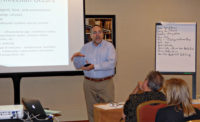As an infectious disease microbiologist who has studied Legionnaires’ disease for over 30 years, I have spent hundreds of hours with plumbing professionals, often alongside them in hot and dirty mechanical spaces. I often joke that this qualifies me as an apprentice in plumbing!
These experiences have given me a unique perspective when thinking about the progress we have made in the prevention of building-associated Legionnaires’ disease.
Forty-seven years after its discovery, we know that potable water, especially the warm water systems of large buildings like hospitals, is the primary source of transmission of this deadly form of bacterial pneumonia.
Unfortunately, the problem of Legionnaires’ disease is not going away. Despite our best efforts, the number of Legionnaires’ disease cases hasn’t decreased but is increasing! According to the CDC, there are about 6,000 new cases of Legionnaires’ disease annually in the U.S. Since 2002, reported cases of the disease went up a staggering 450%. The CDC updates these numbers annually and has speculated that the causes of the increase in cases of Legionnaires’ could be due to aging water system infrastructure, aging population, and better case detection.
You may have heard that Legionella bacteria are in every water system, and it is hopeless to try to control this waterborne bacterium. But this is a myth — Legionella bacteria are not ubiquitous! Based on numerous studies, a good rule of thumb is that about half of large buildings, including hospitals, are colonized with Legionella. Aren’t you curious to know if your building is in the half that is harboring these deadly bacteria?
If Legionella is found, are there simple engineering controls that will prevent the growth and spread of Legionella and protect your building occupants? You might think that routine maintenance will make a difference. And this is also a myth. Legionnaires’ disease is not the result of a poorly maintained water distribution system. We learned early on that simple maintenance like flushing hot water tanks, cleaning aerators, or maintaining a hot water tank at 140o F does not prevent Legionella from happily growing in the building water distribution system — all the way to the point of use at the fixture. Even removing dead legs won’t solve your Legionella problems.
When cases of building-associated Legionnaires’ disease have occurred, achieving control has been difficult. Easy fixes like raising hot water temperature are not permitted by most building codes, especially for buildings housing high-risk occupants such as hospitals and long-term care and nursing homes. The temperature at the fixture would need to be above 120o F for Legionella control. Health care facilities must maintain a much lower hot water temperature, often a temperature that Legionella and other bacteria love —just above body temperature. At these temperatures, Legionella and other bacteria are not controlled. In fact, they’re having a party in your pipes!
During the COVID-19 pandemic, those pathogens really had a party in your pipes. We learned of the dangers of building water systems left unused and stagnating. Could smarter plumbing systems help manage this Legionella risk? The answer is yes! Faucets and showers that flush automatically and at timed intervals are now available. Automatic sensor faucets can be programmed wirelessly to flush the stagnant water out that has been sitting in the line. Keeping water moving and reducing water age can improve overall water quality at the tap.
If you’re looking for guidance on managing stagnant water in your building, check out this new publication. The International Association of Plumbing and Mechanical Officials (IAPMO) and the American Water Works Association (AWWA) published the AWWA/IAPMO Manual-2022: Manual of Recommended Practices for the Safe Closure and Reopening of Building Water Systems. Unfortunately, flushing alone will not stop Legionella. Supplemental water treatment will be necessary if your building is highly colonized. Before implementing supplemental disinfection, consider the plumbing materials. Some pipe materials might not tolerate the disinfectants at the concentrations needed to control Legionella.
You also have to worry about other waterborne pathogens like Pseudomonas aeruginosa. These bacteria can colonize faucets and sink drains and creep up and into the sink. Splash can contaminate surfaces and then infect patients. Smart plumbing options are available to combat this threat too. One smart product continuously cleans and disinfects the p-trap under the sink during normal operation.
If you haven’t already done so, it’s time to meet the Legionella and waterborne pathogen challenge. Implement a water management plan per the industry standard “ANSI/ASHRAE Standard 188-2021: Legionellosis: Risk management for building water systems.” Get the fundamentals in Legionella water management by becoming an ASSE-Certified Water Management Specialist. ASSE Standard 12080 is a professional qualifications standard that requires 24 hours of training before taking the certification exam. Learn more at https://specialpathogenslab.com/asse-12080-certification.
Building owners must assess the Legionella risk and validate their plans by showing that the hazard (Legionella) is controlled. You may be surprised to learn that none of the following have been shown to reliably assess the risk for Legionnaires’ disease, including: chlorine levels, heterotrophic plate count bacteria (HPC), ATP or temperature. It is crucial that building water management team members understand that they cannot use other measures to predict either the presence or absence of Legionella in building water systems.
If we are going the end Legionnaires’ disease, we need to do better. Here’s what you can do today: 1) test for Legionella before cases occur; 2) know if and what kind of Legionella is in your water system; and 3) assess whether your water management plan is working by monitoring for both Legionella and disinfectant levels.
Yes, ending Legionnaires’ disease is a BHAG — a big hairy audacious goal — but technology and smart plumbing design are getting us closer to achieving it!



